The Right Body Measurements and Why They Matter in Fashion Design (A Global Perspective)
In the world of fashion, creativity often takes center stage—with vibrant colors, unique fabrics, and striking designs leading the conversation. But behind every well-designed garment lies something far more fundamental: accurate body measurements. For online businesses, fashion designers, and even social media influencers, understanding the right measurements is a key factor in ensuring comfort, proper fit, and lasting quality—especially when aiming for a global audience.
Accurate measurements do more than define physical appearance. They influence brand identity, reflect cultural heritage through clothing, and support the use of materials that suit a region’s natural resources. With global fashion constantly expanding, paying attention to body size and proportions has become an essential step in great design.
Quick Overview:
– The right body measurements are the foundation of good design.
– Knowing bust, waist, hips, and other key parts ensures comfort and a better fit.
– It also plays a role in building global brand identity beyond just the physical form.
– Accurate sizing helps improve the experience for consumers, designers, and businesses alike.
Why Body Measurements Shape Great Design
Taking body measurements isn’t just about collecting numbers. It guides how each seam is aligned and how fabric should be chosen. These details shape the garment’s silhouette and ensure it matches the needs of today’s diverse markets.
Around the world, body types differ widely. Some regions have generally taller builds, while others may lean toward shorter or broader frames. This pushes many fashion companies to study the average body data of their audiences. With access to actual bust, waist, and hip measurements, designers can adjust patterns and make styles that suit a broader range of shapes.
As awareness of body positivity grows, basic sizing (S, M, L) is no longer enough. Numeric sizes and exact measurements in centimeters are becoming the norm. Designers and businesses that invest in anthropometric data find themselves ahead of the curve—providing better customer satisfaction and building stronger brand loyalty.
How Accurate Sizing Reflects a Brand’s Identity
Some might wonder how body measurements relate to a brand’s image. It’s all about trust and consistency. When a label offers well-fitting clothes, buyers feel understood and are more likely to return.
Fashion labels known for consistent sizing gain a strong reputation over time. When buyers trust a brand to deliver comfort and fit, they’re likely to remain loyal—even when shopping across borders. This credibility contributes to international growth.
Designers who adopt modern tools such as digital body scans or personalized measurement forms often stand out. These efforts show commitment to precision, drawing more attention from global shoppers. With so many cultures to consider, taking body measurements seriously adds real value to a brand’s marketing approach.
Psychological Benefits of the Right Fit
A well-fitting garment doesn’t just look good—it makes people feel good. Whether a piece is tight or loose in just the right places, it helps wearers feel more confident.
Around the world, beauty standards vary, but one thing stays the same: a properly fitted garment makes people feel seen and celebrated. Even the simplest design can stand out when it complements the body well. The ability to make adjustments based on measurements also ensures clothing can evolve with trends or personal preferences—like narrowing a waistline or relaxing a shoulder.
This kind of thoughtful design turns clothing into a personal statement. It’s not just about style but also about honoring each person’s shape. When a designer gets this part right, they’re offering more than clothes—they’re offering self-expression.
Tools That Support Accurate Measurement
Technology now makes it easier to gather and use body measurements. Design software can simulate clothing before a single stitch is made, and 3D scans can provide precise models of the human form. These tools help reduce fabric waste and speed up production.
Larger fashion companies work with tech firms to build data systems that offer customized sizing. These partnerships aim to create efficient production pipelines while keeping fit quality high. With online shopping growing rapidly, accurate digital sizing tools are essential. They let buyers check fit virtually, avoiding the need for in-store fittings.
Some consumer apps now measure the body using a smartphone camera. These measurements can be stored in a user’s profile and used to recommend clothing sizes. Fewer returns and better satisfaction are the natural results.
Key Body Parts Often Measured
- Bust – Measured around the fullest part of the chest, typically at nipple level.
- Waist – Taken at the narrowest part above the belly button.
- Hips – Measured at the fullest part of the lower body, just below the hip bones.
These numbers make it much easier to create or choose clothing that fits well.
How Fabric Choices Connect with Measurements
A designer’s job doesn’t stop at measuring. The next step is choosing fabric that matches the measurements. Cotton, polyester, wool, or silk each react differently to movement and stretch. Understanding a fabric’s weight and elasticity ensures the final piece hangs correctly and feels good.
For example, stretchy fabrics may need less room in the waist. Stiffer materials might need extra allowance for comfort. Each choice must be guided by the body data gathered earlier. That’s how details like seams, lining, and drape are aligned to serve both form and function.
Inclusive Sizing and Respect for All Body Types
Inclusive fashion is growing fast. Today’s brands aim to serve every shape—whether petite, athletic, or plus-size. But none of this is possible without accurate measurement. A strong understanding of these differences leads to better designs that celebrate diversity.
Successful brands don’t push a single standard—they listen to their audience. Some even develop size guides tailored to specific body types. Though building these systems takes time and money, the long-term rewards in customer satisfaction and brand credibility are undeniable.
Why Education Still Matters
Fashion schools place great emphasis on measurement skills and pattern creation. These lessons are more than technical know-how—they’re the backbone of smart design. A small mistake in sizing can ruin the entire structure of a garment.
On a personal level, shoppers also benefit from knowing their own measurements, especially when buying online. Understanding how to measure bust, waist, and hips reduces returns and saves time. It also helps shoppers choose brands that align better with their shape.
As more people gain this knowledge, better communication grows between brands and consumers—resulting in fewer wasted resources and better buying decisions.
Real-World Examples and Their Impact
Some European companies now offer customization tools where customers enter their body data and choose style preferences. From collar shape to sleeve length, the final garment is made to match their input. In Asia, well-known tailors combine old-school measuring tapes with high-end scanning tools to double-check accuracy.
Even if your business isn’t as advanced, body measurement still has value. For content creators in fashion, teaching followers how to measure themselves builds trust and authority. When your audience finds your advice helpful, they come back for more.
Building Consumer Trust Through Size Transparency
Clear sizing builds confidence. When shoppers feel that their body type is respected, they’re more likely to support the brand. A detailed sizing system sends a simple but powerful message: “Your body matters.”
Online or in-store, showing people how to measure properly and displaying helpful visuals creates a smoother buying experience. Happy customers are more likely to return, helping a brand grow across cultures and regions.
Working with Other Sectors to Improve Fit
This isn’t just a designer’s job. Anthropologists, ergonomics experts, and medical researchers all help deepen the understanding of body structure. New clothing lines now aim for both style and performance—like activewear that boosts circulation or improves breathability.
When all these fields work together, even simple garments like T-shirts become more thoughtful. Traditional wear like the kimono or barong can also evolve with modern shapes, honoring culture while updating form.
Reducing Waste with Precise Measurements
Precision helps reduce waste. Less fabric is thrown away when sizes are planned in advance. Cutting and sewing mistakes often result from poor measurements—and they harm both profits and the environment.
Globally, the fashion industry faces growing pressure to act sustainably. Better measurements lead to cleaner production and lower carbon footprints. Everyone wins: the designer, the customer, and the planet.
Balancing Comfort and Style
A beautiful design means little if it doesn’t feel good to wear. Comfortable clothes build confidence. In a global market, style and comfort must go hand-in-hand. Most people won’t sacrifice ease just for looks.
Body measurements connect the two. They help define the right skirt length, shoulder width, and other small choices that add up to a great look. For some, it’s about art and meaning. For others, it’s about daily comfort. Either way, the right fit makes all the difference.
Precise body measurements shape more than a piece of clothing—they shape trust, confidence, and creativity. They allow brands to serve more people, with better results. When designers and customers are aligned, the outcome is thoughtful design built on mutual respect.
Taking measurement seriously means believing that everyone deserves clothes that fit—not just physically, but emotionally. And when a brand delivers that, it truly stands out in a global world.


